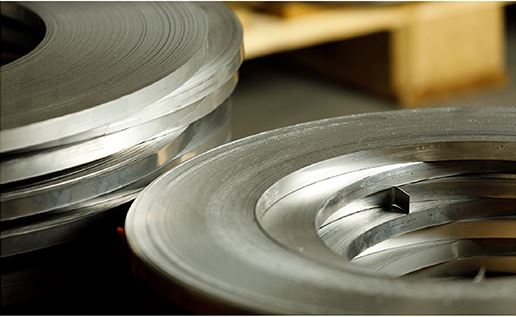If stainless steel is mentioned in the context of building and construction, invariably it is the “iconic” Chrysler Building in New York that will come up sooner or later. And perhaps with good reason. The roof panels on the building have been around since 1930; they have only been cleaned three times since then, and even today show only limited signs of corrosion.
This perhaps sums up why the building and construction sector has become one of the main growth markets for stainless steel. It is, as again is invariably pointed out, “aesthetically pleasing”, but also corrosion resistant and therefore long lasting, and to top it all, recyclable at the end of its useful life.
But there is a bit more to stainless steel than meets the eye, and the team on the front line at Stainless Band, who have been working closely with many companies in the building and construction sector over many years, know this very well.
For a start, there is actually no such thing as “stainless steel”. Everything rusts or stains eventually. So the kind of questions that need to be asked are: are you planning to put this “stainless” material into a hot and dry environment, a marine environment, a cold urban environment (subject perhaps to salt spray from the road), or indeed in a highly polluted environment? This will partly determine the grade – get it wrong, and it will rust.
Next, what type of surface finish do you specify? You may like the look of a mirror finish, because it looks bright and shiny, and beautiful, and reflects the clouds, but if you were a pilot about to land at an airport, you might quickly come to the conclusion that a matte finish would have been more suitable.
Going back to grades again for a moment, it might be worth analysing building and construction. Are we talking about cladding, or purely decorative uses, or are we talking about structural applications? In which case, we will have to consider tensile strength etc, which again will be determined by the grade.
Cost is always a factor in any building and construction project, as Stainless Band is well aware, and stainless steel has become widely regarded as being a very expensive product. This may have been the case when nickel was at the $50,000/tonne level, but at $10,000 or $11,000/tonne, this would not seem to be such a problem. More important than the price of nickel, however, is the life cycle cost. Use a carbon steel product, and you will have to paint it regularly, and within a few years replace it. All this costs money.
And there are ways and means of avoiding what in the past have been extraordinary prices for nickel which, of course, are only really relevant when talking about austenitic stainless steel grades. New developments mean that today you can opt for a lean duplex grade which may have even higher corrosion resistance properties than austenitic grade 316L, but contains less nickel (and is therefore cheaper or at least more stable in price), but has higher strength (so you can use thinner gauges, thereby again reducing cost). And, in fact, there are now even some highly corrosion resistant ferritic grades that may be suitable for the particular application.
Unfortunately, it doesn’t end here. All of this care and attention paid to selecting the “right” material will, of course, come to nought, if this material is stored, transported, processed, welded, or installed incorrectly.
Iron contamination, which will lead to rusting, will inevitably result if non-stainless steel material is used for handling, or if processing equipment which has been used on carbon steel products is subsequently used on “stainless” material. And, once you have identified the correct welding procedure for the particular grade and product that is being welded, you may need to consider whether post-weld cleaning is required – whether that be grinding, polishing, pickling, or passivating.
To summarize, you need to talk to the experts if you want stainless steel to perform correctly. And when it comes to stainless steel, and to its use in the building and construction sector, you can find all the experts you need at Stainless Band.
If you get it right, it will last a long time, need not be as expensive as you think (certainly not over the long term), will look good, needs little maintenance, and is fire resistant. And at the end of the day, this material will, more often than not, be collected, melted in an arc furnace, and become a new coil or sheet, or new bar, rod or wire.
Richard Clark, Editor of Stainless Steel Focus and journalist (expert on stainless steel)

Posted on: 18-08-2017
You may also like
Update on Stainless Pricing October 2022
September 2022

Stainless steel prices have increased for October as we enter the final quarter of 2022. Nickel is back to US$24,000, which has seen increases in alloy surcharges for October of 5%, and there are also expected base price increases.
Update on Stainless Pricing September 2022
September 2022

Stainless Steel prices have seen a calmer period as we enter the fourth quarter of 2022 as the Nickel price fell to US$22,000, which helped reduce alloy surcharges for August/September.


